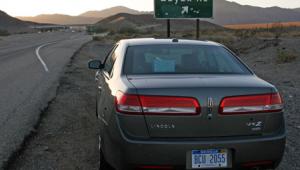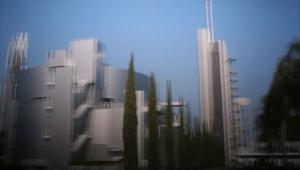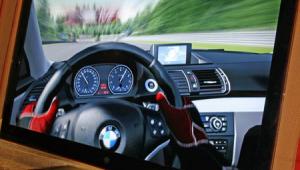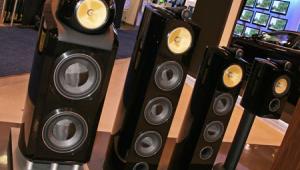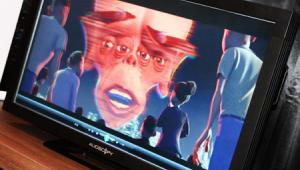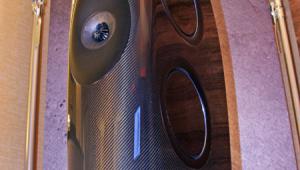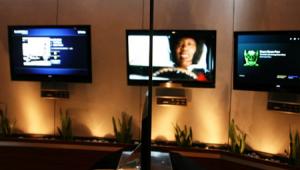15 Miles

Of course, the big story at the show was 3Dit was everywhere. After seeing many demos, I'm still not convinced that I want to watch it all the time, or even at all. Some sort of glasses are mandatory, and they have several inherent disadvantages. Foremost in my view is that all types of glasses significantly reduce the amount of light reaching the eyes, making the image quite dim unless the display can output much more light than it would for 2D content. Many people find them uncomfortable to wear for extended periods, especially if they wear regular glasses as I do, and you must have a pair for each person, which could get expensive.
Also, the integration of different "depths" remains unconvincing in many cases, especially with objects in the near foreground. Finally, the image is prone to "ghosting" (which looks like double vision), and the resolution is often cut in half, depending on the specific display technology being used.
During the show, I kept wondering if 3D is something consumers are clamoring for or if it's being pushed on an uncaring marketplace by manufacturers and studios. I suspect the latter, since it offers them yet another way to sell more products. However, this strategy could backfire as consumers learn that they must buy a new display and Blu-ray player to take advantage of 3D content, which is especially irksome if they just bought an HDTV and Blu-ray player.
The quality of the 3D images I saw varied widely. I preferred the look of systems with active shutter glasses over passive polarized glasses, and direct-view sets seemed to look better than front-projection systems. My favorite 3D demos were from Mitsubishi (RPTVs that looked better than I've ever seen with 3D material), Panasonic, Samsung, and Sony, all of which used active glasses. One of the Mits demos used a new type of glasses synchronization in which a white frame is flashed on the screen periodically rather than using an infrared emitter. This seemed to increase the apparent brightness of the image a bit, which is a good thing with 3D.
Surprisingly, JVC's 3D demo using two RS4000s, each with 4K resolution, exhibited some ghosting, which a rep attributed to the cheap polarized glasses they were using. Dude, this was 3D's big rolloutyou spent a bundle on the booth, so why cheap out on the glasses? On the other hand, JVC's 4K 2D image on a 16-foot-wide Da-Lite Affinity 0.9-gain screen was spectacularthe best video image I saw at the show. The Samsung SP-A900B projector on the same (though smaller) screen in Da-Lite's booth also looked gorgeous.
In other display news, LED-illuminated LCD TVs abounded, including value-oriented models from Vizio and Westinghouse as well as all-singing, all-dancing powerhouses from Toshiba, Samsung, Sony, and LG and everything in between. Both edge-lit and backlit models were well-represented except at Samsung, which showed no new LED-backlit sets this year. When I asked why, the official response was that the company saw no way to significantly improve on LED backlighting without a big increase in cost and power consumption, whereas its improvements in edge lighting bring the performance of that technology close to backlighting. Samsung's floor demos included several 2009 models next to the equivalent 2010 sets, and the new ones did look better, but it's impossible to really see what's going on in such a bright environment; I look forward to seeing what they can do in our testing studio.
Of course, edge lighting allows thinner cabinets, another strong trend at CES, with some concept units measuring only a quarter of an inch thick, though many 2010 models are under an inch. I was amazed to learn that LG's super-slim concept piece uses LED backlighting, not edge lightinghow the heck did they accomplish that? In many LED-backlit sets, the number of local-dimming zones has increased from around 100 to as many as 500, which should greatly improve haloing around bright objects on a dark background.
I'm very glad to report that plasma is far from dead. Panasonic, Samsung, and LG all showed new models that looked great as far as I could tell in that non-ideal environment, and many were 3D-capable. For some unfathomable reason, Panasonic upped the size of its monster plasma from 150 inches last year to 152 this year, even though it had no competition as the largest flat panel at the show. The 4K image on that bad boy looked fantastic, like looking out a really big window.
There wasn't much home-theater sound on the show floor or at the Venetian, where all the high-end, mostly 2-channel audio companies set up shop. I heard some great sound over there, though most hotel rooms don't do these systems justice.
And so I bid a fond farewell to CES 2010. I had a great time, but I'm really glad to be back homeby the end of the show, my dogs were really barking! I'm eager to take a closer look at some of the products I saw there as they become available, mostly in the summer and fall. In the meantime, I think I'll put my feet up for a little while.
